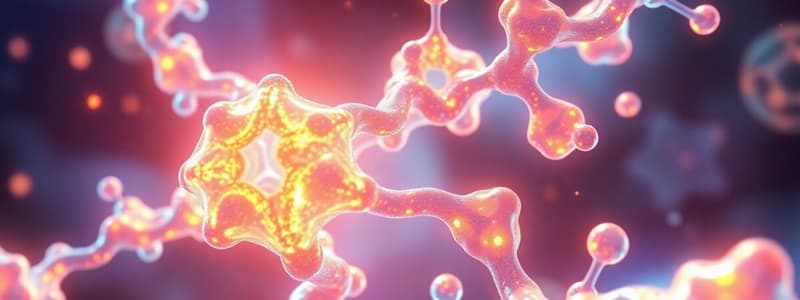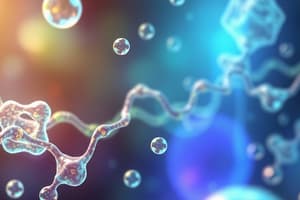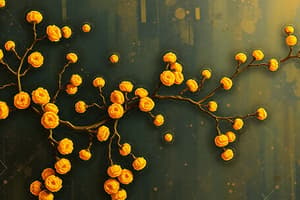Podcast
Questions and Answers
Which of the following macromolecules serves primarily as structural support in plant cells?
Which of the following macromolecules serves primarily as structural support in plant cells?
- Cellulose (correct)
- Glycogen
- Starch
- Chitin
What is the bond type called that forms between two monosaccharides to create a disaccharide?
What is the bond type called that forms between two monosaccharides to create a disaccharide?
- Glycosidic linkage (correct)
- Ionic bond
- Peptide bond
- Hydrogen bond
Which of these carbohydrates is primarily used for energy storage in animals?
Which of these carbohydrates is primarily used for energy storage in animals?
- Cellulose
- Fructose
- Sucrose
- Glycogen (correct)
Which carbohydrate has a 1,4 beta linkage, making it indigestible to humans?
Which carbohydrate has a 1,4 beta linkage, making it indigestible to humans?
Which of the following correctly describes the composition of carbohydrates?
Which of the following correctly describes the composition of carbohydrates?
What type of bond primarily stabilizes the alpha helix and beta pleated sheet structures in proteins?
What type of bond primarily stabilizes the alpha helix and beta pleated sheet structures in proteins?
Which of the following characteristics contributes to the tertiary structure of proteins?
Which of the following characteristics contributes to the tertiary structure of proteins?
What is a common characteristic of hydrophobic R groups in amino acids?
What is a common characteristic of hydrophobic R groups in amino acids?
Which of the following statements correctly describes the quaternary structure of a protein?
Which of the following statements correctly describes the quaternary structure of a protein?
Which component of nucleic acids is responsible for their overall negative charge?
Which component of nucleic acids is responsible for their overall negative charge?
What is the primary structure of proteins composed of?
What is the primary structure of proteins composed of?
What type of bond forms between adjacent amino acids?
What type of bond forms between adjacent amino acids?
Which statement about the R group of amino acids is true?
Which statement about the R group of amino acids is true?
What type of bond is involved in the stabilization of protein tertiary structure?
What type of bond is involved in the stabilization of protein tertiary structure?
What are the two functional groups present in all amino acids?
What are the two functional groups present in all amino acids?
What is the difference between the sugar found in DNA and RNA?
What is the difference between the sugar found in DNA and RNA?
Which pair of nitrogenous bases is correctly matched with the number of hydrogen bonds they form?
Which pair of nitrogenous bases is correctly matched with the number of hydrogen bonds they form?
What characteristic distinguishes purines from pyrimidines?
What characteristic distinguishes purines from pyrimidines?
Which statement correctly describes the orientation of DNA strands?
Which statement correctly describes the orientation of DNA strands?
Which of the following is true regarding the structure of lipids?
Which of the following is true regarding the structure of lipids?
Flashcards
Monosaccharide
Monosaccharide
A carbohydrate monomer (simple sugar) that serves as a primary energy source in cells. Examples include glucose, fructose, and galactose.
Polysaccharide
Polysaccharide
A carbohydrate polymer made up of many monosaccharides linked together. Examples include starch, glycogen, cellulose, and chitin.
Glycosidic Linkage
Glycosidic Linkage
The bond that connects monosaccharides together to form disaccharides and polysaccharides.
Starch
Starch
Signup and view all the flashcards
Cellulose
Cellulose
Signup and view all the flashcards
Peptide Bond
Peptide Bond
Signup and view all the flashcards
Primary Structure
Primary Structure
Signup and view all the flashcards
Secondary Structure
Secondary Structure
Signup and view all the flashcards
Tertiary Structure
Tertiary Structure
Signup and view all the flashcards
Quaternary Structure
Quaternary Structure
Signup and view all the flashcards
DNA (Deoxyribonucleic Acid)
DNA (Deoxyribonucleic Acid)
Signup and view all the flashcards
RNA (Ribonucleic Acid)
RNA (Ribonucleic Acid)
Signup and view all the flashcards
Thymine (T)
Thymine (T)
Signup and view all the flashcards
Phosphodiester Linkage
Phosphodiester Linkage
Signup and view all the flashcards
What is the primary structure of a protein?
What is the primary structure of a protein?
Signup and view all the flashcards
What are the secondary structures of a protein?
What are the secondary structures of a protein?
Signup and view all the flashcards
What is the tertiary structure of a protein?
What is the tertiary structure of a protein?
Signup and view all the flashcards
What is the quaternary structure of a protein?
What is the quaternary structure of a protein?
Signup and view all the flashcards
What are the three types of R-groups and how do they affect protein folding?
What are the three types of R-groups and how do they affect protein folding?
Signup and view all the flashcards
Study Notes
Macromolecules
- Four macromolecules (carbohydrates, proteins, nucleic acids, lipids) are crucial for biological processes.
- Each has a unique structure and function.
Carbohydrates
- Composed of carbon, hydrogen, and oxygen (1:2:1 ratio).
- Monomer: monosaccharide (e.g., glucose, fructose, galactose).
- Polymer: polysaccharide.
- Glucose structure: ring structure; chemical formula C6H12O6.
- Dehydration reaction joins two monosaccharides to form a disaccharide (e.g., sucrose, lactose, maltose).
- Bond between monosaccharides: glycosidic linkage.
- Polysaccharides: cellulose (plant cell walls, structural), chitin (fungi cell walls, exoskeletons), starch (plant energy storage), glycogen (animal energy storage).
- Starch and cellulose differ in glycosidic linkage (alpha-1,4 for starch; beta-1,4 for cellulose) - allowing us to break one but not the other.
- Symbiotic relationships exist (termite gut microbes breaking down cellulose).
Proteins
- Composed of carbon, hydrogen, oxygen, nitrogen, and sometimes sulfur.
- Monomer: amino acid.
- Amino acid structure: central carbon bonded to an amino group (NH2), a carboxyl group (COOH), a hydrogen atom, and a variable R group.
- Peptide bond forms between the carboxyl group of one amino acid and the amino group of the next.
- Directionality: N-terminus (amino end) to C-terminus (carboxyl end).
- Protein structure levels:
- Primary: linear sequence of amino acids.
- Secondary: alpha helix or beta-pleated sheet (hydrogen bonds in the protein backbone).
- Tertiary: 3D structure formed by various bonds (covalent, ionic, hydrogen, van der Waals, hydrophobic interactions) between R groups.
- Quaternary: multiple polypeptides forming a larger protein (e.g., collagen, hemoglobin).
- R groups can be hydrophobic, hydrophilic, or charged.
- Hydrophobic R groups fold inward, while hydrophilic ones fold outwards.
- Charged ones can form ionic bonds with water or other polar molecules.
Nucleic Acids
- Composed of carbon, hydrogen, oxygen, nitrogen, and phosphorus (in phosphate groups).
- Monomer: nucleotide.
- Nucleotide structure: phosphate group, nitrogenous base (adenine, guanine, cytosine, thymine/uracil), and a pentose sugar (deoxyribose/ribose).
- Phosphodiester linkage joins nucleotides.
- Directionality: 5' end (phosphate) to 3' end (hydroxyl).
- DNA structure: double helix; antiparallel strands; base pairing (A-T with two hydrogen bonds; C-G with three hydrogen bonds).
- RNA structure: single-stranded; contains uracil instead of thymine.
- Differences between DNA and RNA: sugar type (deoxyribose vs. ribose) and strandedness.
Lipids
- Composed of carbon, hydrogen, and oxygen.
- Non-polar.
- Not polymers (no repeating monomer units).
- Types:
- Fats (triglycerides): glycerol backbone + 3 fatty acids linked by ester bonds.
- Saturated fats (all single bonds) are solid at room temperature.
- Unsaturated fats (at least one double bond) are liquid at room temperature (oils).
- Phospholipids: glycerol backbone + 2 fatty acids + phosphate group.
- Amphipathic (polar head, non-polar tails).
- Form bilayers in water.
- Steroids: four fused carbon rings (e.g., cholesterol, hormones). Key roles in cell signaling.
- Fats (triglycerides): glycerol backbone + 3 fatty acids linked by ester bonds.
Water Properties
- Polar covalent bonds (unequal electron sharing).
- Hydrogen bonds between water molecules.
- Cohesion: water molecules attracted to each other.
- Adhesion: water molecules attracted to other polar substances.
- Capillary action: combined effect of cohesion and adhesion.
- Surface tension: resistance to increase in surface area due to hydrogen bonds.
- Water is a universal solvent.
- High specific heat: resists changes in temperature.
- Ice is less dense than liquid water (hydrogen bonds stabilize crystal structure).
- Evaporative cooling: heat absorbed to change water from liquid to gas phase.
- pH: negative logarithm of hydrogen ion concentration (inverse relationship); pH scale (acidic/basic), significant for biological systems.
Studying That Suits You
Use AI to generate personalized quizzes and flashcards to suit your learning preferences.




